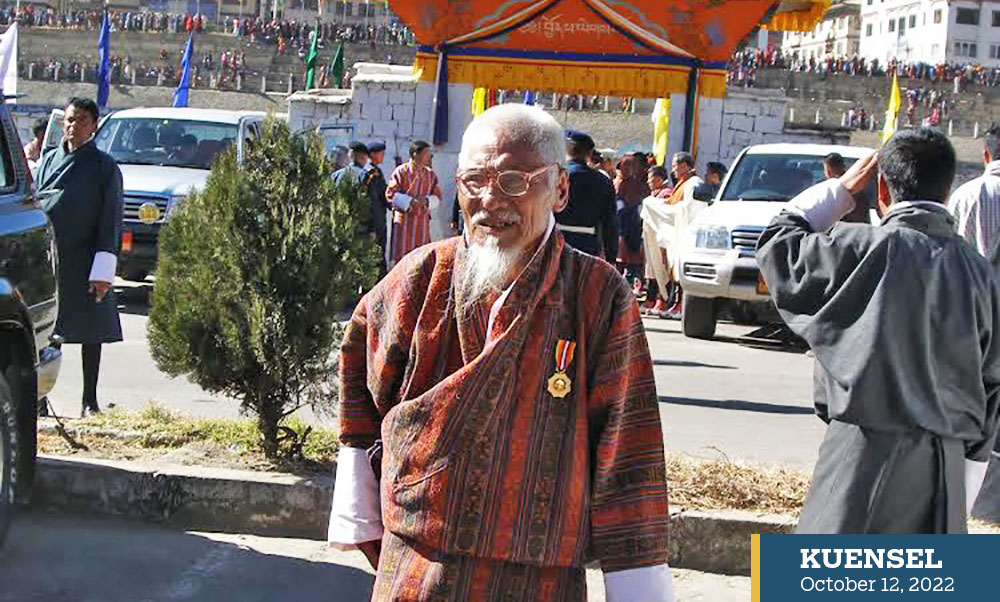Rinzin Wangchuk
Renowned Bhutanese singer, dancer and musician, Ap Dawpel will be remembered by the people of Bhutan, especially his students, as an unparalleled maestro of folk music instruments and performance of traditional Zhungdra songs.
Druk Thuksey (Heart Son of Bhutan) medal recipient, Ap Dawpel passed away at his residence in Motithang, Thimphu on September 28. He was 91.
A relative of Ap Dawpel said that Jojo (great grandfather) was not well because of his old age. “Despite his poor health, Jojo used to sing “Thrungla Ya Ya” (a traditional song dedicated to Zhabdrung Ngawang Namgyel) when his followers and well-wishers came to see him,” she said.
From Talo Nobgang, Ap Dawpel’s real name was Dawa Peljor also called Kinzang Tshering when he was a mask dancer at the Punakha Dzong.
Ap Dawpel, who picked up his flute at the age of nine, spent the rest of his life with folk musical instruments- lim (flute), chiwang (violin), and dranyen (lute).
Ethnocologist Jigme Drukpa and musician Kheng Sonam Dorji, both students of Ap Dawpel, described their master as a great artist and distinguished folk musician in the country. They remember him as the most esteemed ambassador of music in Bhutan.
“As a Bhutanese musician and composer, Ap Dawpel was best known for popularising the Bhutanese folk instrument dranyen all over the world. Bhutan definitely lost a master,” Kheng Sonam Dorji said.
He said that Ap Dawpel’s presentations of music, belonging to the house of Talo dangrem style, were very pure and authentic.
“Ap Dawpel was a person, wholly immersed into music, who never competed with or had reserves about any other musician.”
Calling the late maestro Apa, Jigme Drukpa said that Apa was a deeply spiritual person with a high sense of humour, wit and clarity about all things he did. He was a simple man and wanted no material possessions, but would be out to fight against anyone if he knew he wasn’t wrong.
“Bhutan lost an unparalleled maestro of folk music instruments, folk and mask dances, painting, embroidery, song writing, storytelling and performance of zhungdra songs,” Jigme Drukpa said.
Ap Dawpel’s contributions
After 58 years into folk music, Ap Dawpel’s contribution in preserving traditional music in Bhutan was recognised when His Majesty the Fourth Druk Gyalpo awarded him the Druk Thuksey medal on June 2, 1999. After receiving the award, Ap Dawpel said that he got the award because of the blessings of Lhamo Yangchenma (Goddess of music and wisdom).
As a young boy from Talo, Ap Dawpel’s parents enrolled him into the clergy. At the age of 18 he began playing the flute out of his own personal interest. He had said that no one taught him how to play.
Soon, he was recruited for a music group assembled in Dechenphodrang. Even as a young monk, he was often called to play for the Royal Bhutan Army band. He left the clergy at the age of 23 and it was then that he learned to play the dranyen, and took to zhungdra songs from his teacher and friend Sewla Pem Dorji.
Ap Dawpel’s life took a turn when, at 25, he started work as a painter because of his kikhor teacher in the clergy. During the renovation of the Tashichhodzong in the 1960s he was nominated as a master painter and he continued painting for about 25 years before he finally retired.
Ap Dawpel had entertained guests like late Prime Minister of India, Jawaharlal Nehru and his grandson, Rajiv Gandhi, during their State visits to Bhutan. His music provides the background for the film on Prime Minister Nehru’s visit to Bhutan and other films.
Some of Ap Dawpel’s well-known songs were Lhasa Norbuling la, Gesar Janglu Joenbe Gang, and Tashi Laso. He also released many dranyen solo albums.
Ap Dawpel, who was instrumental in propagating zhungdra and dhang (tune), married three times, his first at the age of 25, and had a daughter from each.


